Wireless Networking and Communication Report: Antenna Technologies
VerifiedAdded on 2020/03/04
|10
|1447
|36
Report
AI Summary
This report provides a detailed analysis of wireless networking and communication technologies. It begins by examining various antenna types, including Yagi-uda, horn, and cellular antennas, discussing their strengths, weaknesses, and applications. The report then delves into a comparison and contrast of FDMA and CDMA technologies, highlighting their key differences and uses. Furthermore, it explores recent advancements in wireless technologies, such as RFID, and evaluates their strengths and weaknesses. The report concludes by considering the best antenna types for future applications, particularly in the context of long-distance communication. This report is designed to provide a comprehensive overview of the current landscape and future trends in wireless networking.
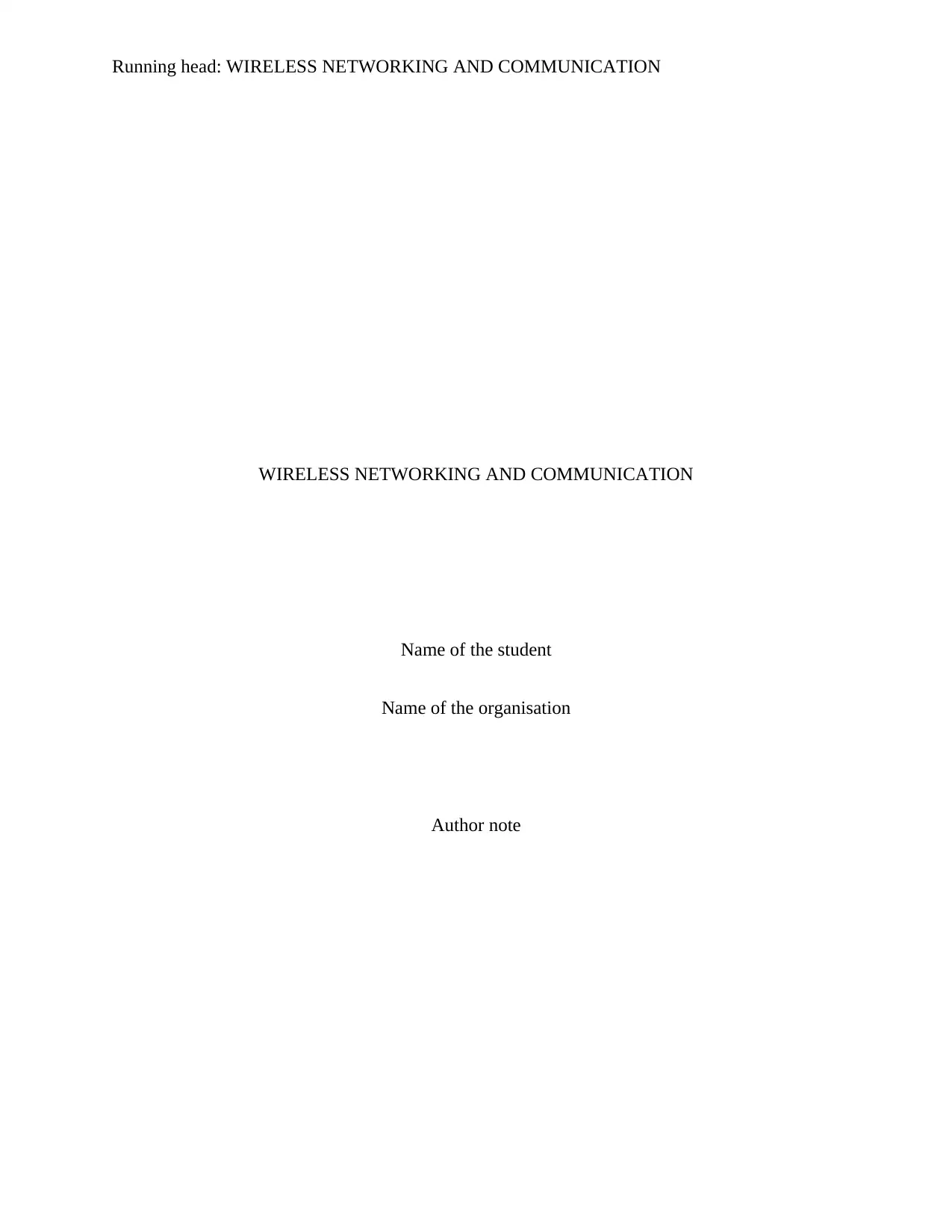
Running head: WIRELESS NETWORKING AND COMMUNICATION
WIRELESS NETWORKING AND COMMUNICATION
Name of the student
Name of the organisation
Author note
WIRELESS NETWORKING AND COMMUNICATION
Name of the student
Name of the organisation
Author note
Paraphrase This Document
Need a fresh take? Get an instant paraphrase of this document with our AI Paraphraser
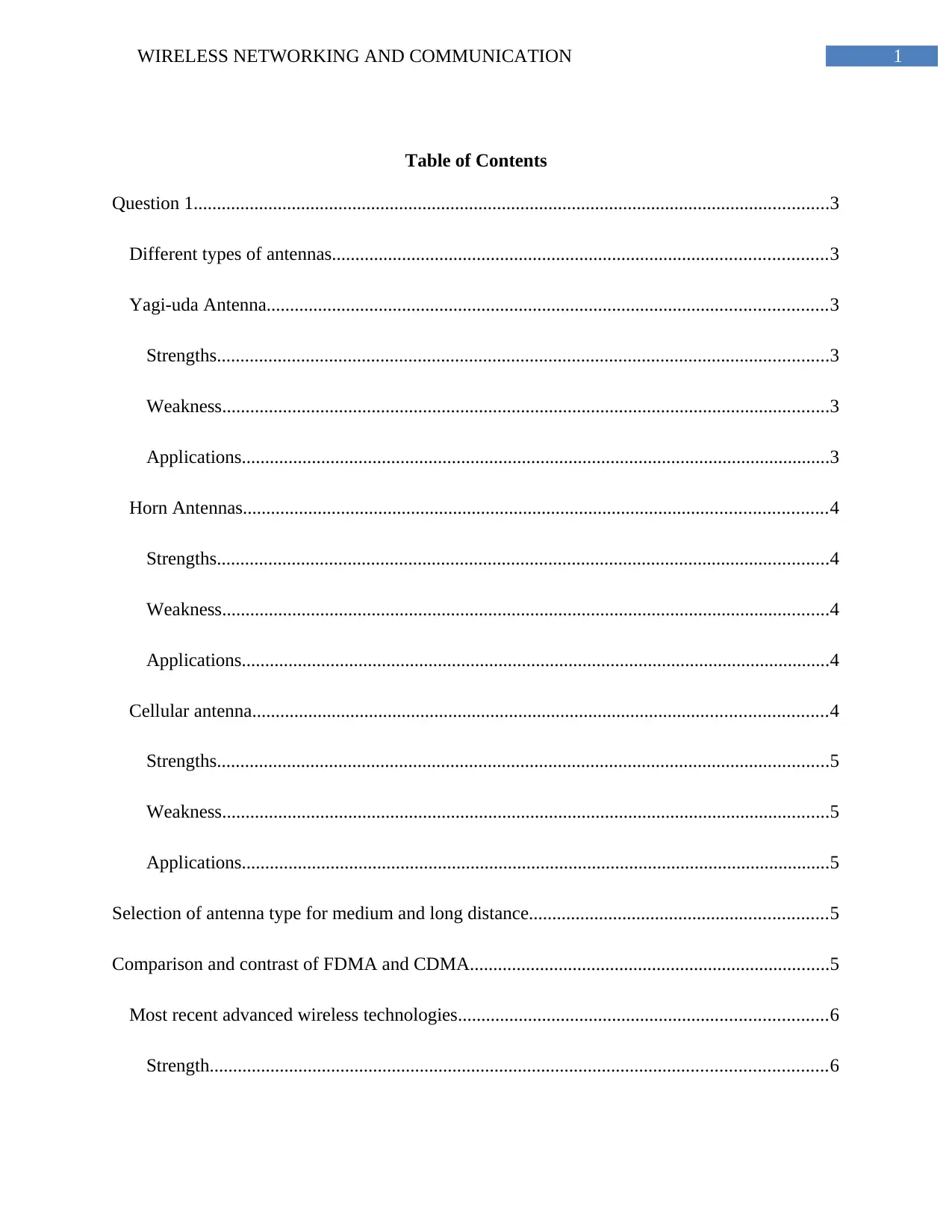
1WIRELESS NETWORKING AND COMMUNICATION
Table of Contents
Question 1........................................................................................................................................3
Different types of antennas..........................................................................................................3
Yagi-uda Antenna........................................................................................................................3
Strengths...................................................................................................................................3
Weakness..................................................................................................................................3
Applications..............................................................................................................................3
Horn Antennas.............................................................................................................................4
Strengths...................................................................................................................................4
Weakness..................................................................................................................................4
Applications..............................................................................................................................4
Cellular antenna...........................................................................................................................4
Strengths...................................................................................................................................5
Weakness..................................................................................................................................5
Applications..............................................................................................................................5
Selection of antenna type for medium and long distance................................................................5
Comparison and contrast of FDMA and CDMA.............................................................................5
Most recent advanced wireless technologies...............................................................................6
Strength....................................................................................................................................6
Table of Contents
Question 1........................................................................................................................................3
Different types of antennas..........................................................................................................3
Yagi-uda Antenna........................................................................................................................3
Strengths...................................................................................................................................3
Weakness..................................................................................................................................3
Applications..............................................................................................................................3
Horn Antennas.............................................................................................................................4
Strengths...................................................................................................................................4
Weakness..................................................................................................................................4
Applications..............................................................................................................................4
Cellular antenna...........................................................................................................................4
Strengths...................................................................................................................................5
Weakness..................................................................................................................................5
Applications..............................................................................................................................5
Selection of antenna type for medium and long distance................................................................5
Comparison and contrast of FDMA and CDMA.............................................................................5
Most recent advanced wireless technologies...............................................................................6
Strength....................................................................................................................................6

2WIRELESS NETWORKING AND COMMUNICATION
Weakness..................................................................................................................................7
Best type of Antenna for future applications...............................................................................7
References........................................................................................................................................8
Weakness..................................................................................................................................7
Best type of Antenna for future applications...............................................................................7
References........................................................................................................................................8
⊘ This is a preview!⊘
Do you want full access?
Subscribe today to unlock all pages.

Trusted by 1+ million students worldwide
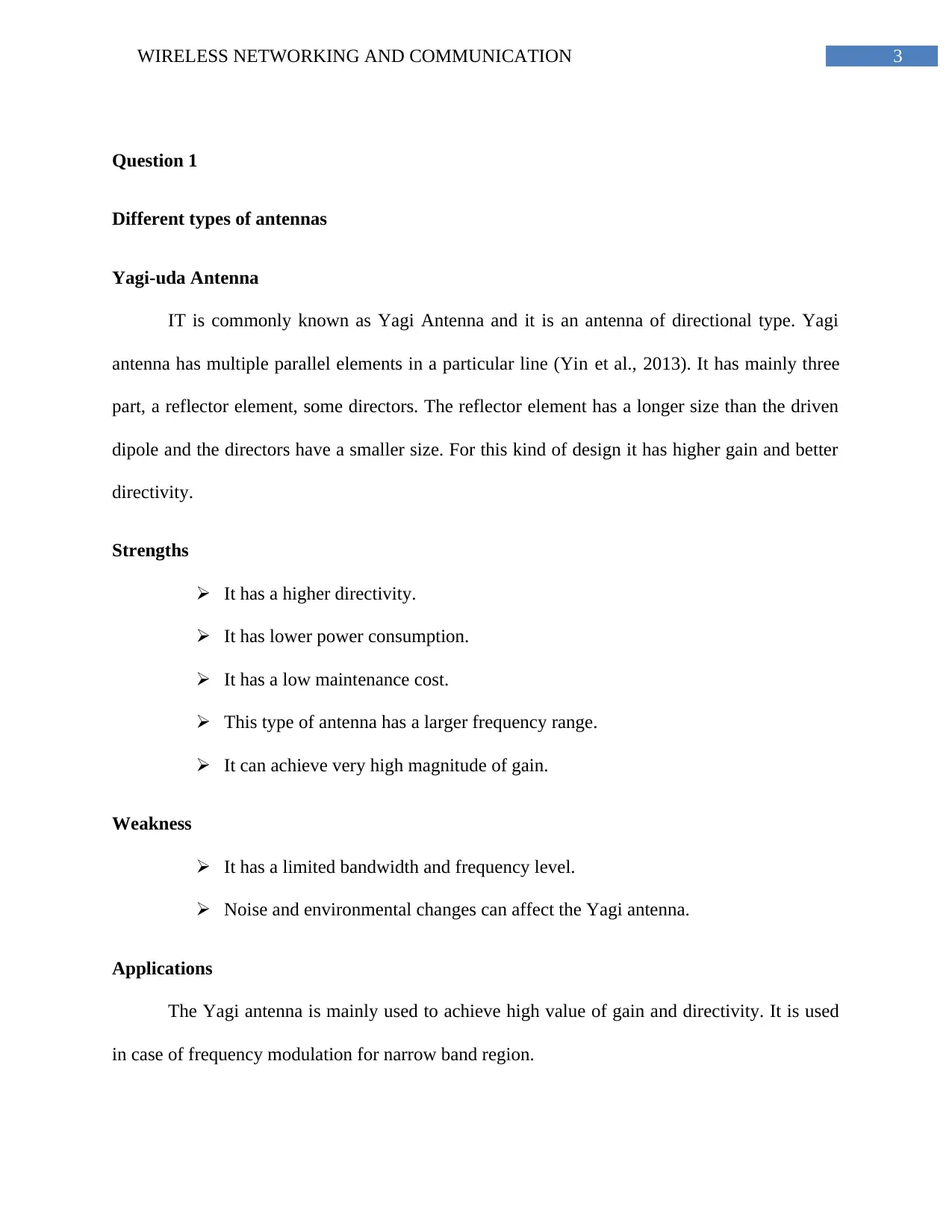
3WIRELESS NETWORKING AND COMMUNICATION
Question 1
Different types of antennas
Yagi-uda Antenna
IT is commonly known as Yagi Antenna and it is an antenna of directional type. Yagi
antenna has multiple parallel elements in a particular line (Yin et al., 2013). It has mainly three
part, a reflector element, some directors. The reflector element has a longer size than the driven
dipole and the directors have a smaller size. For this kind of design it has higher gain and better
directivity.
Strengths
It has a higher directivity.
It has lower power consumption.
It has a low maintenance cost.
This type of antenna has a larger frequency range.
It can achieve very high magnitude of gain.
Weakness
It has a limited bandwidth and frequency level.
Noise and environmental changes can affect the Yagi antenna.
Applications
The Yagi antenna is mainly used to achieve high value of gain and directivity. It is used
in case of frequency modulation for narrow band region.
Question 1
Different types of antennas
Yagi-uda Antenna
IT is commonly known as Yagi Antenna and it is an antenna of directional type. Yagi
antenna has multiple parallel elements in a particular line (Yin et al., 2013). It has mainly three
part, a reflector element, some directors. The reflector element has a longer size than the driven
dipole and the directors have a smaller size. For this kind of design it has higher gain and better
directivity.
Strengths
It has a higher directivity.
It has lower power consumption.
It has a low maintenance cost.
This type of antenna has a larger frequency range.
It can achieve very high magnitude of gain.
Weakness
It has a limited bandwidth and frequency level.
Noise and environmental changes can affect the Yagi antenna.
Applications
The Yagi antenna is mainly used to achieve high value of gain and directivity. It is used
in case of frequency modulation for narrow band region.
Paraphrase This Document
Need a fresh take? Get an instant paraphrase of this document with our AI Paraphraser
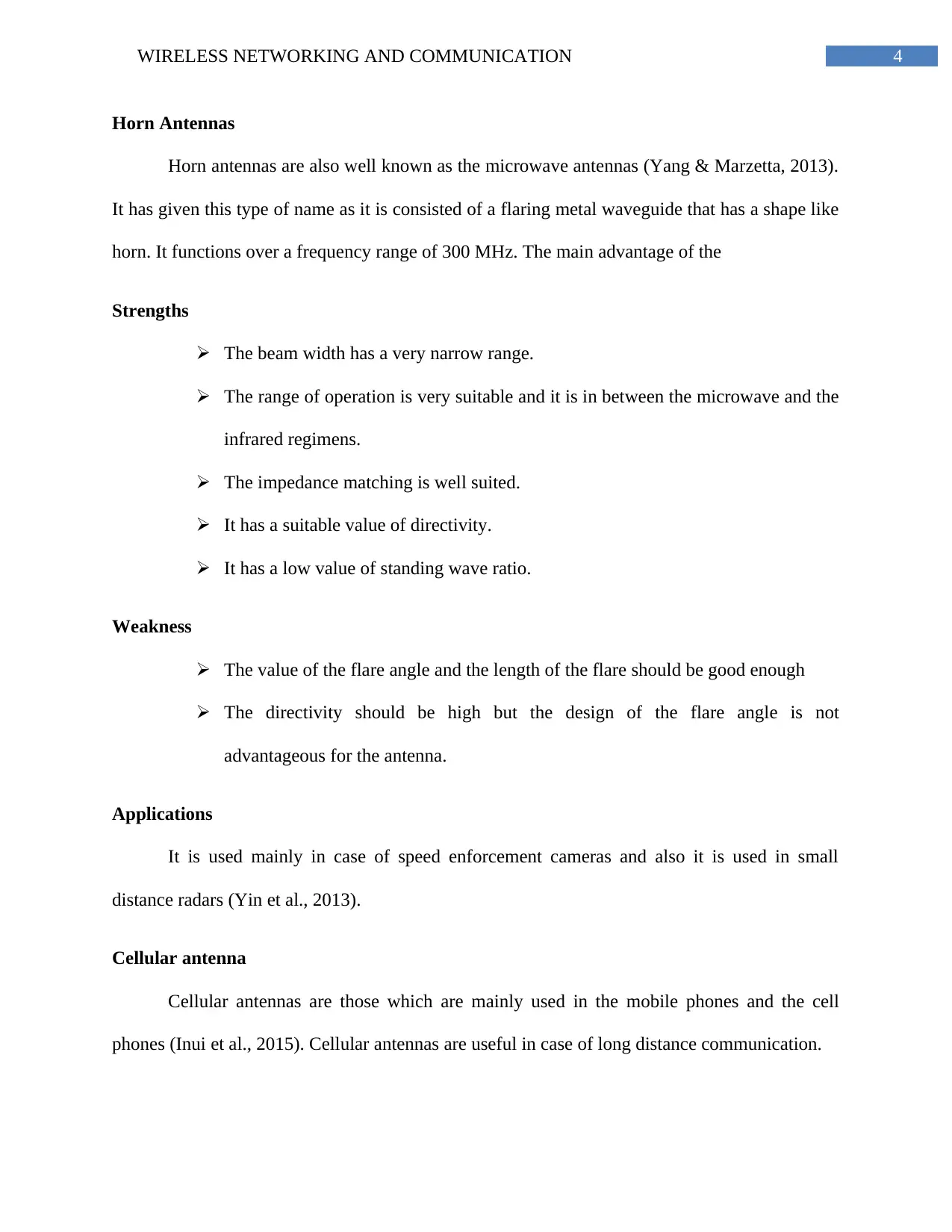
4WIRELESS NETWORKING AND COMMUNICATION
Horn Antennas
Horn antennas are also well known as the microwave antennas (Yang & Marzetta, 2013).
It has given this type of name as it is consisted of a flaring metal waveguide that has a shape like
horn. It functions over a frequency range of 300 MHz. The main advantage of the
Strengths
The beam width has a very narrow range.
The range of operation is very suitable and it is in between the microwave and the
infrared regimens.
The impedance matching is well suited.
It has a suitable value of directivity.
It has a low value of standing wave ratio.
Weakness
The value of the flare angle and the length of the flare should be good enough
The directivity should be high but the design of the flare angle is not
advantageous for the antenna.
Applications
It is used mainly in case of speed enforcement cameras and also it is used in small
distance radars (Yin et al., 2013).
Cellular antenna
Cellular antennas are those which are mainly used in the mobile phones and the cell
phones (Inui et al., 2015). Cellular antennas are useful in case of long distance communication.
Horn Antennas
Horn antennas are also well known as the microwave antennas (Yang & Marzetta, 2013).
It has given this type of name as it is consisted of a flaring metal waveguide that has a shape like
horn. It functions over a frequency range of 300 MHz. The main advantage of the
Strengths
The beam width has a very narrow range.
The range of operation is very suitable and it is in between the microwave and the
infrared regimens.
The impedance matching is well suited.
It has a suitable value of directivity.
It has a low value of standing wave ratio.
Weakness
The value of the flare angle and the length of the flare should be good enough
The directivity should be high but the design of the flare angle is not
advantageous for the antenna.
Applications
It is used mainly in case of speed enforcement cameras and also it is used in small
distance radars (Yin et al., 2013).
Cellular antenna
Cellular antennas are those which are mainly used in the mobile phones and the cell
phones (Inui et al., 2015). Cellular antennas are useful in case of long distance communication.
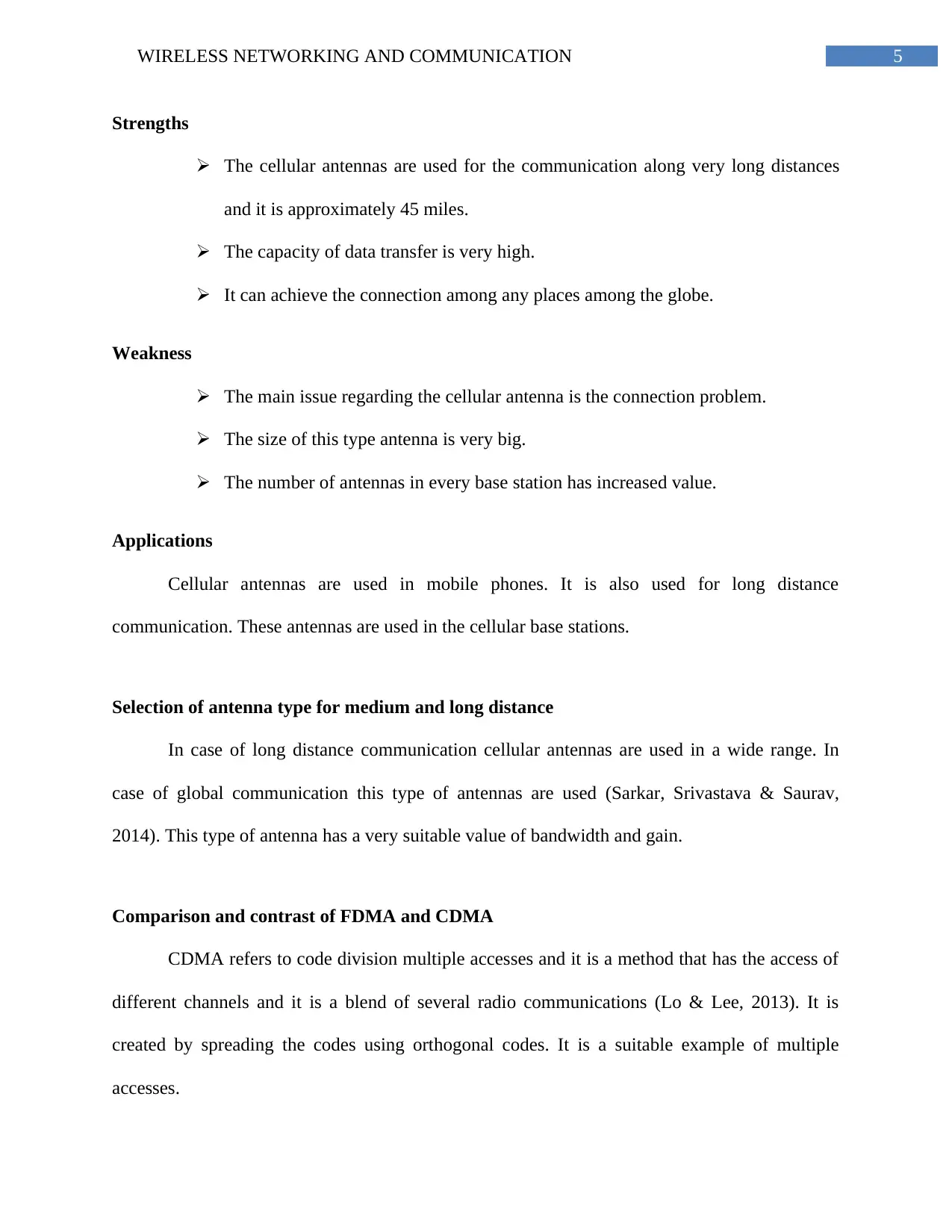
5WIRELESS NETWORKING AND COMMUNICATION
Strengths
The cellular antennas are used for the communication along very long distances
and it is approximately 45 miles.
The capacity of data transfer is very high.
It can achieve the connection among any places among the globe.
Weakness
The main issue regarding the cellular antenna is the connection problem.
The size of this type antenna is very big.
The number of antennas in every base station has increased value.
Applications
Cellular antennas are used in mobile phones. It is also used for long distance
communication. These antennas are used in the cellular base stations.
Selection of antenna type for medium and long distance
In case of long distance communication cellular antennas are used in a wide range. In
case of global communication this type of antennas are used (Sarkar, Srivastava & Saurav,
2014). This type of antenna has a very suitable value of bandwidth and gain.
Comparison and contrast of FDMA and CDMA
CDMA refers to code division multiple accesses and it is a method that has the access of
different channels and it is a blend of several radio communications (Lo & Lee, 2013). It is
created by spreading the codes using orthogonal codes. It is a suitable example of multiple
accesses.
Strengths
The cellular antennas are used for the communication along very long distances
and it is approximately 45 miles.
The capacity of data transfer is very high.
It can achieve the connection among any places among the globe.
Weakness
The main issue regarding the cellular antenna is the connection problem.
The size of this type antenna is very big.
The number of antennas in every base station has increased value.
Applications
Cellular antennas are used in mobile phones. It is also used for long distance
communication. These antennas are used in the cellular base stations.
Selection of antenna type for medium and long distance
In case of long distance communication cellular antennas are used in a wide range. In
case of global communication this type of antennas are used (Sarkar, Srivastava & Saurav,
2014). This type of antenna has a very suitable value of bandwidth and gain.
Comparison and contrast of FDMA and CDMA
CDMA refers to code division multiple accesses and it is a method that has the access of
different channels and it is a blend of several radio communications (Lo & Lee, 2013). It is
created by spreading the codes using orthogonal codes. It is a suitable example of multiple
accesses.
⊘ This is a preview!⊘
Do you want full access?
Subscribe today to unlock all pages.

Trusted by 1+ million students worldwide
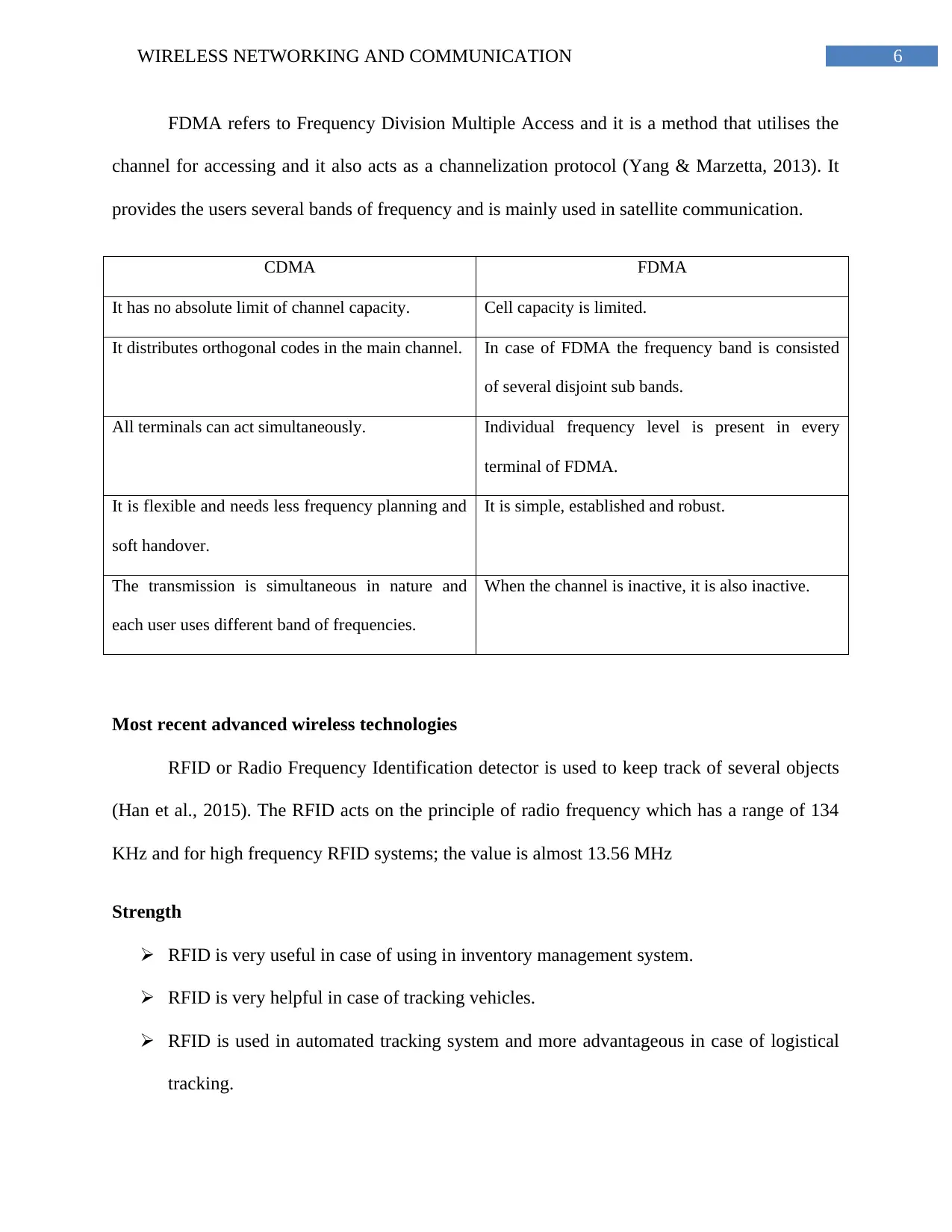
6WIRELESS NETWORKING AND COMMUNICATION
FDMA refers to Frequency Division Multiple Access and it is a method that utilises the
channel for accessing and it also acts as a channelization protocol (Yang & Marzetta, 2013). It
provides the users several bands of frequency and is mainly used in satellite communication.
CDMA FDMA
It has no absolute limit of channel capacity. Cell capacity is limited.
It distributes orthogonal codes in the main channel. In case of FDMA the frequency band is consisted
of several disjoint sub bands.
All terminals can act simultaneously. Individual frequency level is present in every
terminal of FDMA.
It is flexible and needs less frequency planning and
soft handover.
It is simple, established and robust.
The transmission is simultaneous in nature and
each user uses different band of frequencies.
When the channel is inactive, it is also inactive.
Most recent advanced wireless technologies
RFID or Radio Frequency Identification detector is used to keep track of several objects
(Han et al., 2015). The RFID acts on the principle of radio frequency which has a range of 134
KHz and for high frequency RFID systems; the value is almost 13.56 MHz
Strength
RFID is very useful in case of using in inventory management system.
RFID is very helpful in case of tracking vehicles.
RFID is used in automated tracking system and more advantageous in case of logistical
tracking.
FDMA refers to Frequency Division Multiple Access and it is a method that utilises the
channel for accessing and it also acts as a channelization protocol (Yang & Marzetta, 2013). It
provides the users several bands of frequency and is mainly used in satellite communication.
CDMA FDMA
It has no absolute limit of channel capacity. Cell capacity is limited.
It distributes orthogonal codes in the main channel. In case of FDMA the frequency band is consisted
of several disjoint sub bands.
All terminals can act simultaneously. Individual frequency level is present in every
terminal of FDMA.
It is flexible and needs less frequency planning and
soft handover.
It is simple, established and robust.
The transmission is simultaneous in nature and
each user uses different band of frequencies.
When the channel is inactive, it is also inactive.
Most recent advanced wireless technologies
RFID or Radio Frequency Identification detector is used to keep track of several objects
(Han et al., 2015). The RFID acts on the principle of radio frequency which has a range of 134
KHz and for high frequency RFID systems; the value is almost 13.56 MHz
Strength
RFID is very useful in case of using in inventory management system.
RFID is very helpful in case of tracking vehicles.
RFID is used in automated tracking system and more advantageous in case of logistical
tracking.
Paraphrase This Document
Need a fresh take? Get an instant paraphrase of this document with our AI Paraphraser
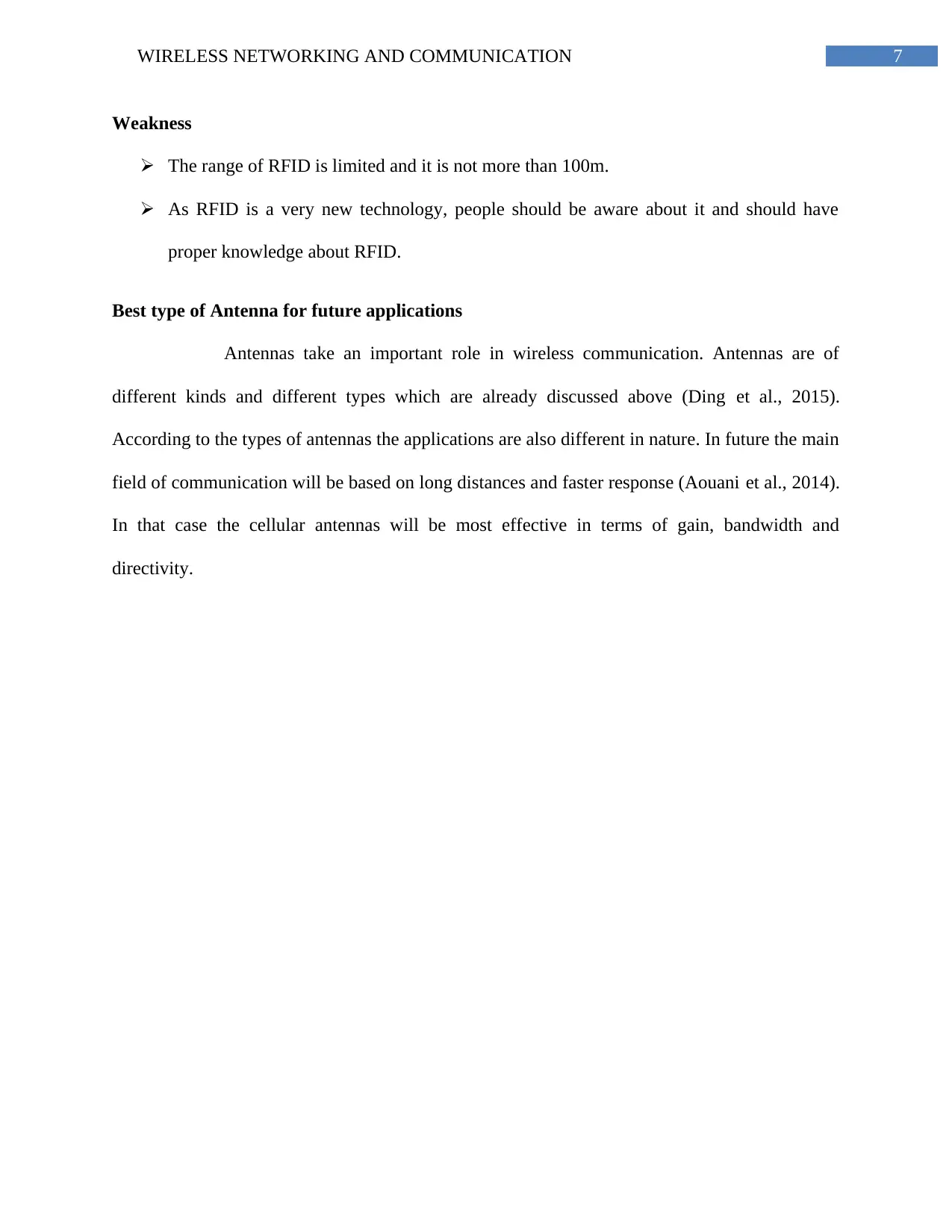
7WIRELESS NETWORKING AND COMMUNICATION
Weakness
The range of RFID is limited and it is not more than 100m.
As RFID is a very new technology, people should be aware about it and should have
proper knowledge about RFID.
Best type of Antenna for future applications
Antennas take an important role in wireless communication. Antennas are of
different kinds and different types which are already discussed above (Ding et al., 2015).
According to the types of antennas the applications are also different in nature. In future the main
field of communication will be based on long distances and faster response (Aouani et al., 2014).
In that case the cellular antennas will be most effective in terms of gain, bandwidth and
directivity.
Weakness
The range of RFID is limited and it is not more than 100m.
As RFID is a very new technology, people should be aware about it and should have
proper knowledge about RFID.
Best type of Antenna for future applications
Antennas take an important role in wireless communication. Antennas are of
different kinds and different types which are already discussed above (Ding et al., 2015).
According to the types of antennas the applications are also different in nature. In future the main
field of communication will be based on long distances and faster response (Aouani et al., 2014).
In that case the cellular antennas will be most effective in terms of gain, bandwidth and
directivity.
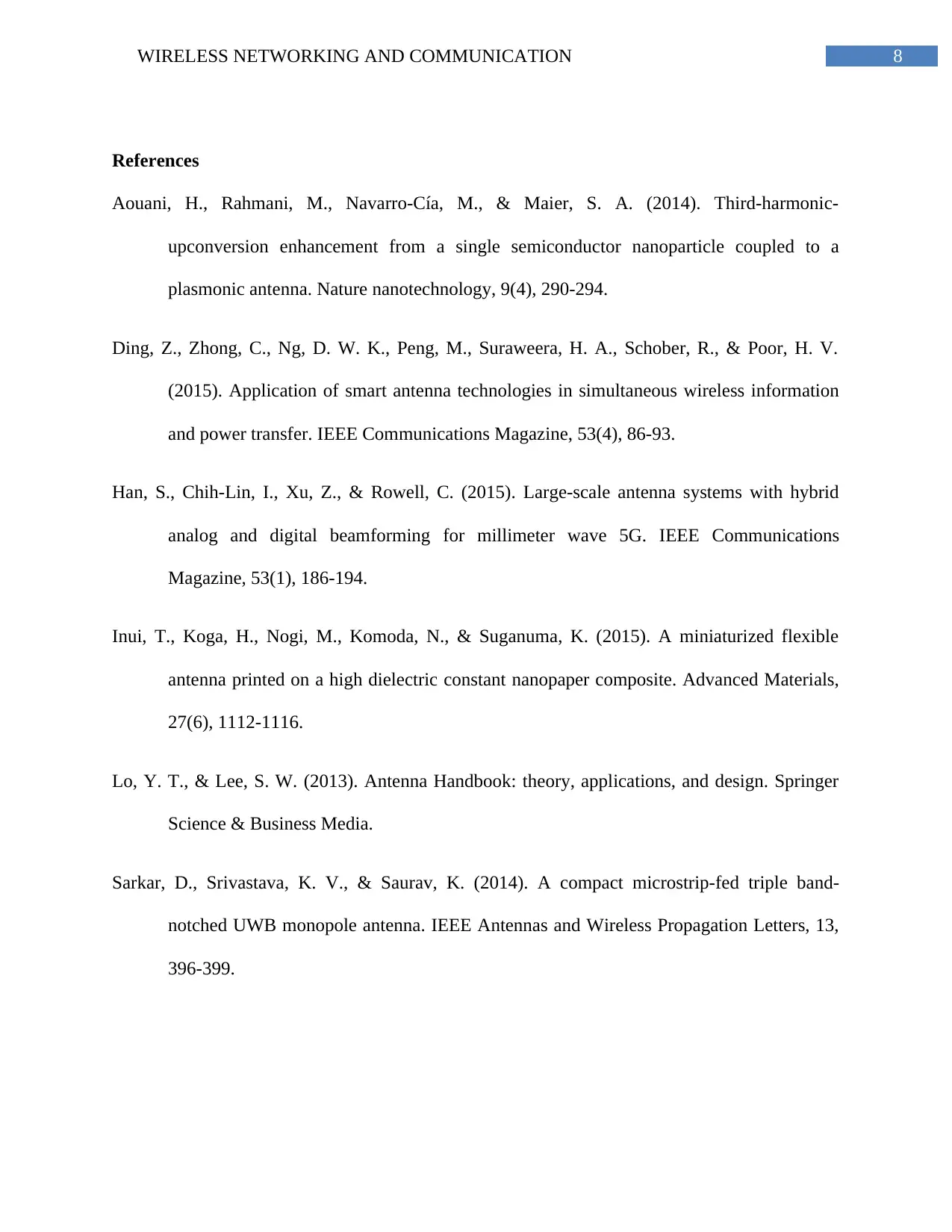
8WIRELESS NETWORKING AND COMMUNICATION
References
Aouani, H., Rahmani, M., Navarro-Cía, M., & Maier, S. A. (2014). Third-harmonic-
upconversion enhancement from a single semiconductor nanoparticle coupled to a
plasmonic antenna. Nature nanotechnology, 9(4), 290-294.
Ding, Z., Zhong, C., Ng, D. W. K., Peng, M., Suraweera, H. A., Schober, R., & Poor, H. V.
(2015). Application of smart antenna technologies in simultaneous wireless information
and power transfer. IEEE Communications Magazine, 53(4), 86-93.
Han, S., Chih-Lin, I., Xu, Z., & Rowell, C. (2015). Large-scale antenna systems with hybrid
analog and digital beamforming for millimeter wave 5G. IEEE Communications
Magazine, 53(1), 186-194.
Inui, T., Koga, H., Nogi, M., Komoda, N., & Suganuma, K. (2015). A miniaturized flexible
antenna printed on a high dielectric constant nanopaper composite. Advanced Materials,
27(6), 1112-1116.
Lo, Y. T., & Lee, S. W. (2013). Antenna Handbook: theory, applications, and design. Springer
Science & Business Media.
Sarkar, D., Srivastava, K. V., & Saurav, K. (2014). A compact microstrip-fed triple band-
notched UWB monopole antenna. IEEE Antennas and Wireless Propagation Letters, 13,
396-399.
References
Aouani, H., Rahmani, M., Navarro-Cía, M., & Maier, S. A. (2014). Third-harmonic-
upconversion enhancement from a single semiconductor nanoparticle coupled to a
plasmonic antenna. Nature nanotechnology, 9(4), 290-294.
Ding, Z., Zhong, C., Ng, D. W. K., Peng, M., Suraweera, H. A., Schober, R., & Poor, H. V.
(2015). Application of smart antenna technologies in simultaneous wireless information
and power transfer. IEEE Communications Magazine, 53(4), 86-93.
Han, S., Chih-Lin, I., Xu, Z., & Rowell, C. (2015). Large-scale antenna systems with hybrid
analog and digital beamforming for millimeter wave 5G. IEEE Communications
Magazine, 53(1), 186-194.
Inui, T., Koga, H., Nogi, M., Komoda, N., & Suganuma, K. (2015). A miniaturized flexible
antenna printed on a high dielectric constant nanopaper composite. Advanced Materials,
27(6), 1112-1116.
Lo, Y. T., & Lee, S. W. (2013). Antenna Handbook: theory, applications, and design. Springer
Science & Business Media.
Sarkar, D., Srivastava, K. V., & Saurav, K. (2014). A compact microstrip-fed triple band-
notched UWB monopole antenna. IEEE Antennas and Wireless Propagation Letters, 13,
396-399.
⊘ This is a preview!⊘
Do you want full access?
Subscribe today to unlock all pages.

Trusted by 1+ million students worldwide
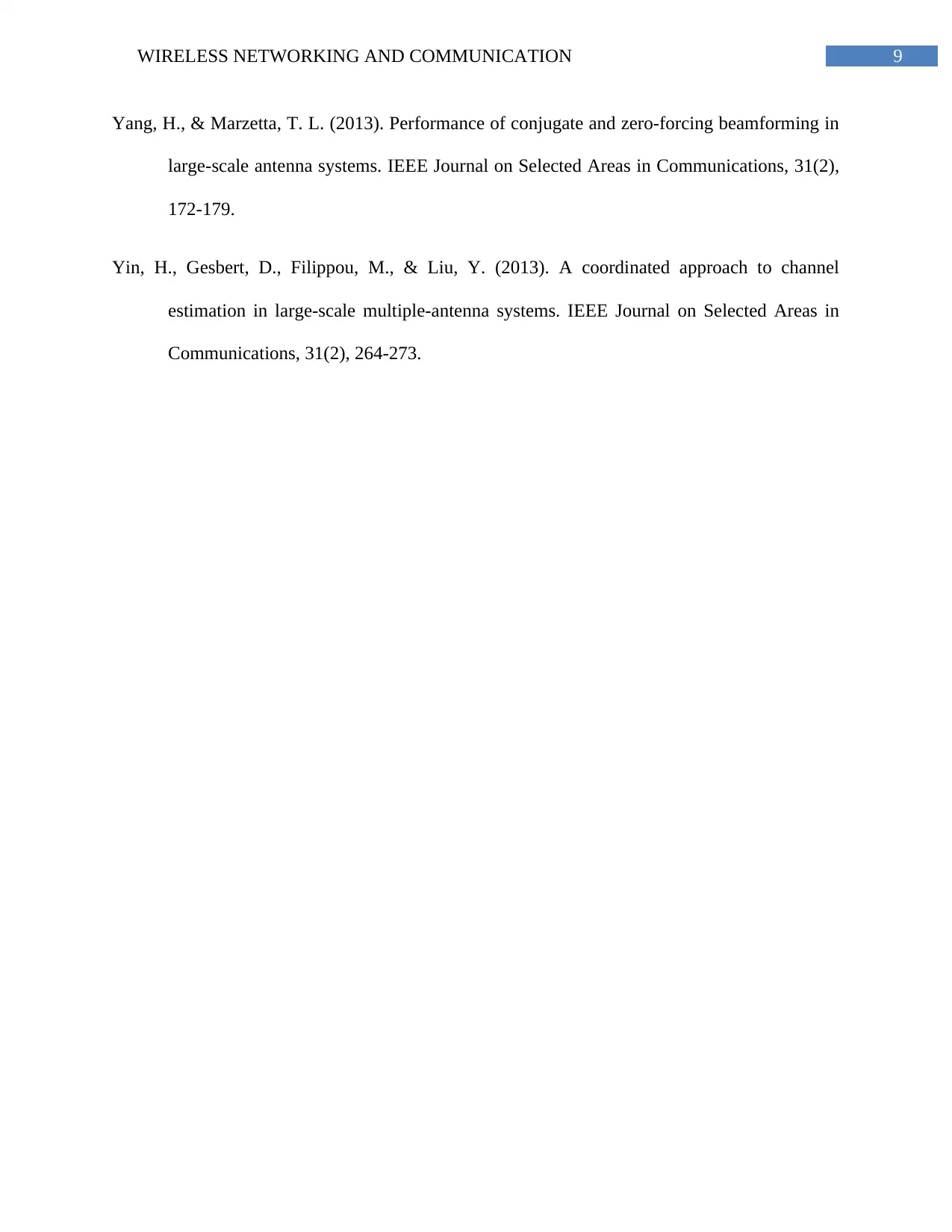
9WIRELESS NETWORKING AND COMMUNICATION
Yang, H., & Marzetta, T. L. (2013). Performance of conjugate and zero-forcing beamforming in
large-scale antenna systems. IEEE Journal on Selected Areas in Communications, 31(2),
172-179.
Yin, H., Gesbert, D., Filippou, M., & Liu, Y. (2013). A coordinated approach to channel
estimation in large-scale multiple-antenna systems. IEEE Journal on Selected Areas in
Communications, 31(2), 264-273.
Yang, H., & Marzetta, T. L. (2013). Performance of conjugate and zero-forcing beamforming in
large-scale antenna systems. IEEE Journal on Selected Areas in Communications, 31(2),
172-179.
Yin, H., Gesbert, D., Filippou, M., & Liu, Y. (2013). A coordinated approach to channel
estimation in large-scale multiple-antenna systems. IEEE Journal on Selected Areas in
Communications, 31(2), 264-273.
1 out of 10
Related Documents
Your All-in-One AI-Powered Toolkit for Academic Success.
+13062052269
info@desklib.com
Available 24*7 on WhatsApp / Email
![[object Object]](/_next/static/media/star-bottom.7253800d.svg)
Unlock your academic potential
Copyright © 2020–2025 A2Z Services. All Rights Reserved. Developed and managed by ZUCOL.




